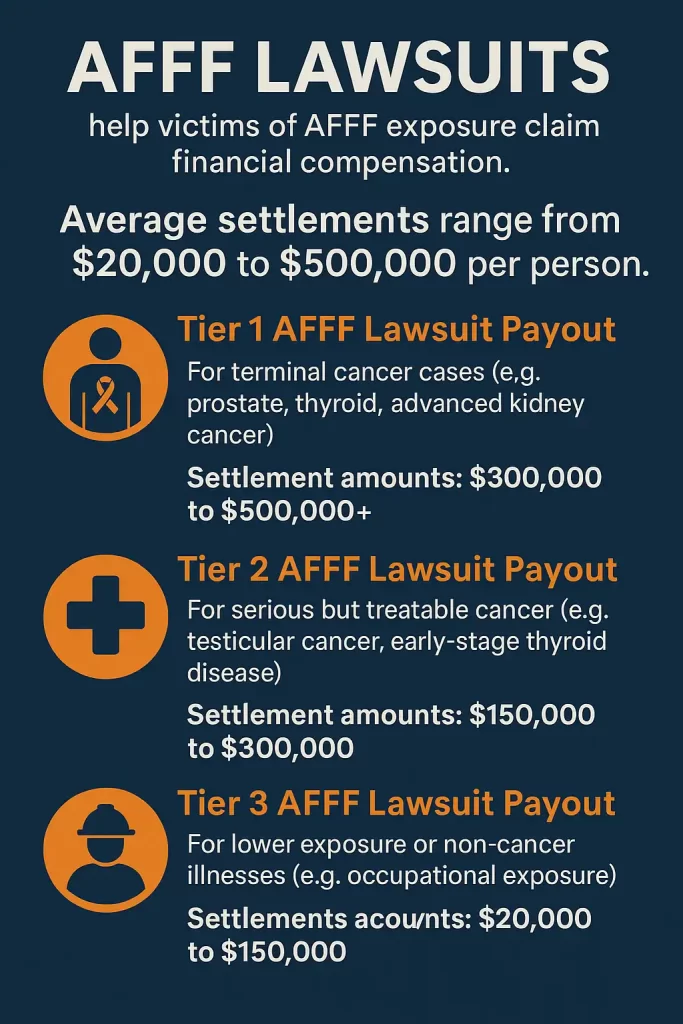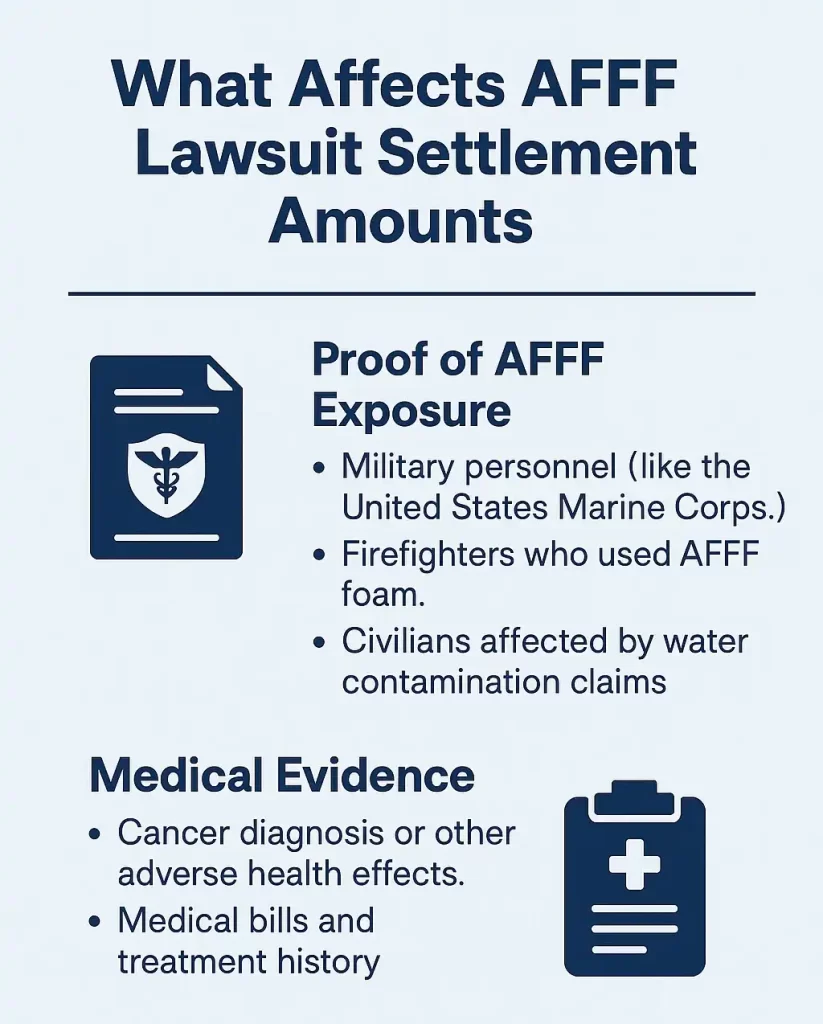- Home
- Personal Injury
- Firefighting Foam AFFF Lawsuit
- AFFF Lawsuit Settlement Amounts
AFFF Lawsuit Settlement Amounts
- Last updated: April 23, 2025
-
Contributor: Sarah Miller
- Fact Checked By Our Attorneys
If you were exposed to AFFF (Aqueous Film Forming Foam), you might wonder what settlement amounts look like. Current estimates suggest AFFF lawsuit settlements range between $20,000 and $500,000 per person. Most cases fall between $175,000 and $325,000, but this depends on your situation.
Your exact payout can vary. Factors like the severity of your illness, medical costs, and length of exposure all play a role. Some people may receive higher settlements, while others might qualify for lower amounts.
Key Takeaways:
- People with serious health issues may get up to $500,000. Others may get between $175,000 and $325,000.
- A new PFAS settlement from April 2024 could pay $10.5 to $12.5 billion for water contamination cases.
- To receive the highest compensation for AFFF exposure, you need a strong lawyer, solid medical records, and environmental test results.
Want to know if you qualify for an AFFF claim?
Get your Free Case Review and Maximize You Payout With the Help From Legal Claim Assistant.
What is AFFF (Aqueous Film Forming Foam)?
AFFF, or Aqueous Film Forming Foam, is a specialized firefighting foam designed to tackle fuel fires, such as those involving jet fuel or gasoline. It works by forming a thin film that effectively cuts off the oxygen supply, allowing it to extinguish the fire rapidly.
For decades, firefighters, military personnel, and airports have relied on AFFF. However, it’s important to note that AFFF contains PFAS chemicals, often referred to as “forever chemicals,” which linger in both the environment and the human body for many years without breaking down.
So, why are lawsuits being filed over AFFF?
People who have been exposed to these toxic firefighting foams are experiencing serious health problems, including various forms of cancer. Many victims allege that companies like 3M, DuPont, and Tyco Fire Products were aware of the risks but chose not to inform the public.
These lawsuits aim to secure financial compensation for medical expenses, emotional suffering, and other damages. A significant number of these cases have been consolidated into the AFFF multidistrict litigation (MDL) taking place in South Carolina.
Understanding PFAS contamination and health risks
The PFAS chemicals found in AFFF can contaminate our water, soil, and air. Individuals may be exposed to PFAS through their jobs (like military firefighters) or by consuming contaminated water.
Research has linked these chemicals to several types of cancer, including kidney, testicular, thyroid, and bladder cancer, among other serious health issues. Those affected by AFFF exposure face the risk of long-term health consequences.
Given the widespread nature of PFAS contamination, the number of firefighting foam cancer lawsuits continues to rise across the United States.

Average AFFF Lawsuit Settlement Amounts per Person
When it comes to AFFF firefighting foam lawsuits, victims have the opportunity to seek financial compensation for their suffering. The amount you might receive really hinges on the severity of your health issues. On average, those involved in AFFF cancer lawsuits can expect settlements ranging from $20,000 to $500,000 per person.
If someone has been diagnosed with a serious form of cancer, like kidney or testicular cancer due to AFFF exposure, the settlement could be even higher.
Tier 1 AFFF Lawsuit Payout
Tier 1 settlements are reserved for individuals facing the most critical health challenges. This includes those battling terminal cancers such as prostate cancer, thyroid cancer, or advanced kidney cancer linked to toxic firefighting foam.
Settlement amounts:
$300,000 to $500,000+
These funds are crucial for covering medical expenses, lost wages, and the emotional toll of such diagnoses.
Tier 2 AFFF Lawsuit Payout
Tier 2 payouts cater to victims with serious but treatable cancer cases. This group includes individuals diagnosed with testicular cancer or early-stage thyroid disease due to PFAS exposure from AFFF firefighting foam.
Settlement amounts:
$150,000 to $300,000
These settlements assist with ongoing medical costs and recovery efforts.
Tier 3 AFFF Lawsuit Payout
Tier 3 cases involve individuals who have experienced lower levels of exposure or less severe health issues. This might include those who have been exposed to firefighting foam products in their jobs but do not have a cancer diagnosis, yet still face health concerns.
Settlement amounts:
$20,000 to $150,000
These cases are often seen among those affected by municipal water contamination.
How much could you receive?
The settlement you might receive will depend on your level of exposure to AFFF, your cancer diagnosis, and the damages you’ve suffered. If you’ve developed cancer or other negative health effects from AFFF firefighting foams, you could be eligible for a personal injury lawsuit.
A lawyer specializing in firefighting foam cases can evaluate your situation and assist you in filing an AFFF lawsuit. Remember, every personal injury claim is unique.
Recent AFFF and PFAS Settlements
Many AFFF firefighting foam lawsuits have led to large settlement deals. These payouts help cancer victims and communities affected by PFAS-containing firefighting foams. Below are the biggest updates.
$10.3 Billion 3M PFAS Settlement
3M agreed to pay $10.3 billion to settle municipal water contamination cases. This deal helps towns and cities clean up PFAS chemicals from drinking water.
It does not directly cover personal injury claims like AFFF cancer cases, but it shows the growing impact of PFAS litigation.
$1.18 Billion Chemours, Corteva & DuPont Settlement
Chemours, Corteva, and DuPont reached a $1.18 billion settlement. This payment is for water contamination lawsuits related to toxic chemicals in firefighting foam products.
This deal also focuses on municipal water contamination cases, not individual AFFF lawsuits.
$750 Million AFFF Settlement Highlights
A $750 million settlement helps resolve several firefighting foam lawsuits. This includes claims from occupational exposure among firefighters and military personnel, like the United States Marine Corps.
This global settlement deal supports victims with medical bills, emotional distress, and health damages caused by AFFF foam.
These firefighting foam settlements are part of the larger AFFF multidistrict litigation (MDL) in South Carolina.

What Influences AFFF Lawsuit Settlement Amounts?
When it comes to AFFF firefighting foam lawsuit settlements, several important factors come into play. These factors determine how much compensation individuals exposed to AFFF can expect to receive.
Proof of AFFF Exposure (Military, Firefighters, Civilians)
To make a strong case in AFFF litigation, victims need to demonstrate that they were indeed exposed to AFFF firefighting foam. This can include:
Military personnel, such as those in the US Marine Corps.
Firefighters who have used AFFF foam in their line of duty.
Civilians who have been impacted by water contamination claims.
Establishing proof of exposure is crucial for personal injury cases related to AFFF.
Medical Evidence (Cancer diagnosis, medical bills, treatment history)
Medical documentation plays a vital role in lawsuits involving firefighting foam. Victims must provide:
A cancer diagnosis or evidence of other negative health effects.
Medical bills and a history of treatment.
This information is essential to support claims for damages in AFFF firefighting foam cases.
Determining Liability (Manufacturer responsibility: 3M, DuPont, others)
Liability is all about identifying which companies are accountable. In AFFF class action lawsuits, manufacturers like 3M, DuPont, and Tyco are frequently named for producing AFFF-contaminated products.
Establishing manufacturer responsibility is a key aspect of AFFF MDL cases in the District of South Carolina.
Severity of Health Conditions (Cancer, Thyroid disease, Ulcerative colitis)
The extent of health issues significantly impacts settlement amounts. More severe conditions, such as:
Kidney cancer.
Thyroid disease.
Ulcerative colitis.
Typically lead to higher compensation for the more serious adverse health effects.
Health Risks Linked to AFFF Exposure
AFFF firefighting foam exposure can cause serious harm to human health. Victims have filed AFFF injury cases because of these risks.
Cancers: Kidney, Testicular, Thyroid, Lymphoma, and More
Many AFFF lawsuits claim that AFFF caused cancer. Common cancers linked to firefighting foam exposure include:
Kidney cancer
Testicular cancer
Thyroid cancer
Lymphoma
These cancers are often part of the AFFF class action lawsuit and the AFFF firefighting foam MDL.
Non-cancer Illnesses: Ulcerative Colitis, Thyroid Disease
Not all AFFF personal injury cases involve cancer. Non-cancer illnesses linked to AFFF exposure include:
Ulcerative colitis (a serious bowel disease)
Thyroid disease (which affects hormone levels)
Victims with these conditions can also file an AFFF lawsuit for financial compensation.
These health risks are central to firefighting foam AFFF lawsuits and the AFFF class action MDL in South Carolina. Firefighting foam lawyers help victims hold companies accountable.
What is the AFFF MDL?
The AFFF MDL, or AFFF multidistrict litigation, is a legal process that brings together numerous lawsuits related to AFFF firefighting foam into a single, larger case. This approach aims to streamline the legal proceedings and ensure that victims receive a fairer chance at justice.
Currently, the AFFF class action MDL is based in the District of South Carolina. It addresses claims from individuals who have been exposed to aqueous film-forming foam (AFFF) and are now facing health issues like cancer. Importantly, victims still have the option to file their own AFFF lawsuits as part of this collective case.
Who are the defendants? (3M, DuPont, Chemours)
Several major corporations are implicated in AFFF lawsuits, including:
3M
DuPont
Chemours
Tyco Fire Products
These companies produced AFFF foam containing PFAS chemicals, often referred to as “forever chemicals.” Victims allege that exposure to these substances has led to serious health problems, including kidney cancer, thyroid cancer, and bladder cancer.
Current status of the MDL and what to expect
The AFFF MDL is currently active and expanding, with thousands of firefighting foam lawsuits under review. Lawyers specializing in firefighting foam cases are diligently working to secure settlement amounts for the victims.
While a final global settlement has yet to be reached, experts anticipate that settlements or trial outcomes could emerge within the next one to two years.
For those who have experienced occupational exposure or have claims related to water contamination, it’s still possible to file an AFFF lawsuit to seek financial compensation.
Do You Qualify for an AFFF Lawsuit?
If you’ve been exposed to AFFF firefighting foam and developed health issues, you may qualify for an AFFF lawsuit. Victims can seek financial compensation for medical expenses, emotional distress, and other damages.
Eligibility Criteria
You may qualify to file an AFFF lawsuit if:
You had occupational exposure as a firefighter, military member, or airport worker.
You lived near a water contamination site affected by AFFF foam.
You received a cancer diagnosis like kidney cancer, testicular cancer, thyroid cancer, bladder cancer, or other adverse health effects linked to PFAS exposure.
If you meet these conditions, you may join the AFFF firefighting foam lawsuits or the AFFF class action lawsuit in the District of South Carolina.
How to File an AFFF claim
Firefighting foam lawyers can help you start a personal injury claim. The process begins with a free consultation. A legal expert will review your AFFF exposure and medical records.
If you qualify, your lawyer will file an AFFF lawsuit as part of the AFFF multidistrict litigation (MDL) or as an individual case. This ensures you have the best chance at a fair lawsuit settlement amount.
Frequently Asked Questions (FAQ) About AFFF Lawsuits and Settlements
Victims of AFFF exposure often have important questions about the legal process and settlement amounts. Below, we answer common questions to help you better understand your rights and options in the AFFF firefighting foam lawsuits.
The AFFF lawsuit settlement amounts can range from $20,000 to $500,000+ per person. The payout depends on:
The severity of health issues like cancer diagnosis (for example, prostate cancer, thyroid cancer, or testicular cancer).
Level of AFFF exposure from firefighting foam.
More severe cancer cases linked to PFAS chemicals often receive higher lawsuit settlement amounts.
The average payout for PFAS settlement varies based on the case. For firefighting foam lawsuits, payouts per person average between $150,000 and $300,000 depending on the health risks and medical expenses.
For water contamination claims, large lawsuit settlements have been reached, such as:
$10.3 billion from 3M.
$1.18 billion from DuPont, Chemours, and Corteva.
These deals focus on cleaning up PFAS contamination, not personal injury claims.
Yes, some AFFF firefighting foam lawsuits have reached settlement agreements. A key example is the $750 million settlement for victims of AFFF exposure.
While many AFFF class action lawsuits remain active in the AFFF MDL in South Carolina, some individual AFFF lawsuits have already been resolved.
More lawsuit settlements are expected as AFFF litigation continues.
Most AFFF firefighting foam lawsuits take 1 to 3 years to settle. The timeline depends on:
The complexity of AFFF litigation.
The number of cases in the AFFF MDL.
Whether it’s a class action lawsuit or an individual case.
Working with experienced firefighting foam lawyers helps speed up the process.
A Tier 1 AFFF lawsuit involves the most severe health issues. This includes victims with:
Prostate cancer, testicular cancer, or other advanced firefighting foam cancer.
High levels of AFFF exposure or PFAS chemicals in the body.
Tier 1 cases often receive the highest AFFF lawsuit settlement amounts.
Usually, an AFFF lawsuit settlement for personal injury (like cancer diagnosis) does not count as taxable income.
However, parts of the lawsuit settlement for lost wages may be taxed. A tax professional can give you exact advice.
The largest lawsuit settlement in history was the $206 billion tobacco settlement.
In PFAS contamination cases, the 3M $10.3 billion settlement for water contamination claims is one of the biggest.
For AFFF firefighting foam lawsuits, individual settlements can reach $500,000+ for severe cancer cases.
Related Article

What Philips CPAP Machines Are Recalled and Why
